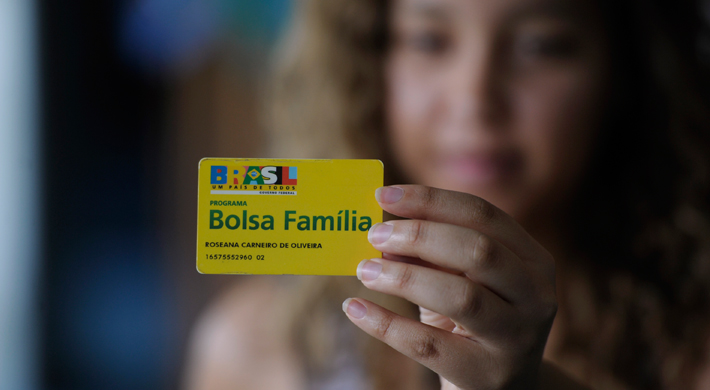
Bolsa Familia (BF) is a conditional cash transfer (CCT) scheme, implemented in Brazil in 2003, and thought to be the world’s largest CCT program. The BF program is organized by the central government in Brasilia, though administered locally by the 5000+ municipalities. Qualifying families – those whose household earnings are in the lowest income quintile – receive a regular cash payment by the BF program, provided the children in the household attend school and receive primary health care. The program has been a major success in Brazil, associated with improvements in children’s educational and health outcomes, and in reducing poverty among the country’s poorest of the poor. The BF program is extremely popular, making it politically difficult to retrench. The scheme is used by nearly 12 million households.
What is most remarkable about Bolsa Familia is its extraordinary record in identifying and reaching the poorest of the poor in Brazil. Consider, however, that many of Brazil’s urban poor live in illegal slums or favelas, or that most of the rural poor live in far-flung villages, far from city centers; in other words, the poor in Brazil are hard to reach because they are hard to find and it is difficult to transfer social services and resources to them. As a Brazilian official once observed: if all the resources spent on social policies in Brazil were dropped from a helicopter, they would have a better chance of reaching the poor than they have now. And yet, the BF is very effective in finding, targeting and ensuring cash transfers make their way to those most in need.
Nearly three-quarters of funds ear-marked to reach those in the bottom income quintile actually make it to targeted households. And most of the funds that miss the poorest 20% (the remaining twenty-five percent of BF funds) are in fact allocated to the next lowest income quintile, the ”œnear poor.” Simply put, the BF program is very precise in reaching its intended beneficiaries; in other comparable Latin American countries, the reach rate is between one-third and one-half. The BF program is unique in minimizing ”œleakage.”
How does the Bolsa Familia program do it? How has it been able to reach the poorest of the poor? Several factors account for the BF program’s success:
â–º Though the BF is a federal program managed by the central government’s Ministry of Social Development (MDS), the actual implementation of the BF scheme is handled by Brazil’s over-5000 municipalities. This arrangement bypasses the state governments, thus eliminating one source of fiscal leakage, corruption and patronage;
â–º Because each municipality administers the BF program, there is considerable latitude among local governments to be innovative in how they ensure compliance, manage cash transfers, target and identify households, and in marketing;
â–º And yet, the BF program is perceived to be a central government program, attributed often to the Lula administration, and as such, beneficiaries are less susceptible to claims of local patronage;
â–º The central government created in 2001 the Cadastro Unico, a unified registry of census and household data which allows the central government to effectively monitor (and refine) the administration of the BF scheme;
â–º The BF program is partnered with the private sector Caixa Economica Federal bank to distribute benefits directly and efficiently to targeted households, leveraging the bank’s existing infrastructure networks and reducing public sector corruption;
â–º Because of the Caixa Bank’s partnership with the BF program, the Caixa has expanded its banking networks throughout the country, incorporating local retailers, lottery houses and bank card technologies;
â–º Poverty in Brazil is understood to be a structural problem, and not the direct fault of the very poor, thus mitigating claims that the poor are undeserving and minimizing social stigma attached to pro-poor programs such as BFP.
In sum: the Bolsa Familia conditional cash transfer scheme heralds a new way of doing development by ensuring the poorest of the poor are reached and thus use the resources allocated to reduce poverty. Some takeaway points:
1. Despite well-institutionalized patterns of patronage politics in the distribution and allocation of resources in Brazil, the BF highlights an important example of where poverty-reduction efforts are actually reaching the poorest of the poor, those most in need;
2. The universalization of social benefits requires that such benefits actually reach those who are the most impoverished and hardest to reach, and the BF program suggests that universalization can be achieved, ironically through precise targeting;
3. The Bolsa Familia program gives many examples of best practices in centrally organized social programs and locally-driven innovation that can be emulated in other late developing countries.
* This brief has been prepared by a University of Toronto research team comprising graduate students Nina DaNoBrega-Garcia and Ariel Sim (Munk School of Global Affairs), and undergraduate students Nicoli Dos Santos, Sarah Ray and Alexa Waud (Faculty of Arts and Science). The research project is being overseen by Professor Joseph Wong, Ralph and Roz Halbert Professor of Innovation at the Munk School, and Canada Research Chair in Political Science, University of Toronto.
Photo by Senado Federal / CC BY 2.0 / modified from original







